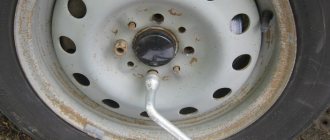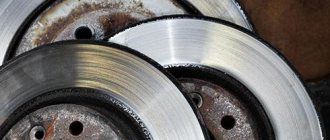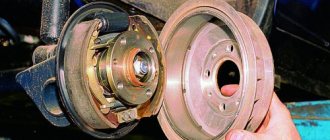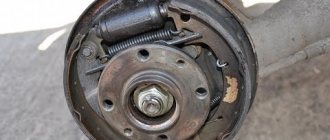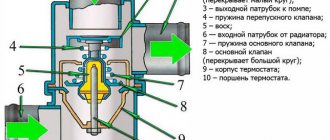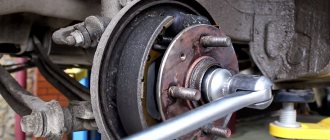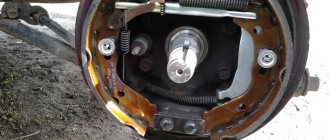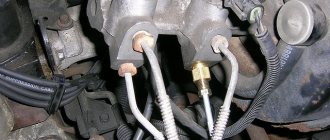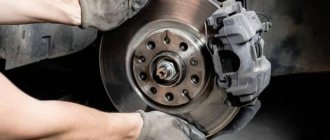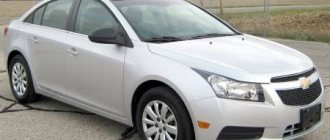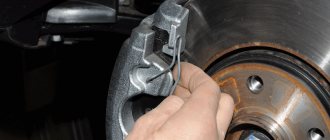If the car is not able to stop in time, there can be no talk of any safe driving. This rule applies to both trucks and cars. VAZ 2107 is no exception in this sense. The brakes of this car have never been famous for their reliability and have always caused drivers a lot of problems. And the most vulnerable point of the brakes on the “seven” have always been the brake discs, the service life of which was very short. Can a car owner change these discs himself? Yes maybe. Let's try to figure out how this is done.
- Types of brake discs
About materials for discs - Design features of brake discs
- Allied Nippon wheels
- Sequence of work
- Sequencing
Correct replacement of brake discs on a VAZ 2107. Don’t create problems for yourself
The mandatory procedure - replacing brake discs on a VAZ 2107 - is one of the safety requirements for owners and owners of the car of the same name.
The replacement process itself is extremely simple and does not require additional devices (except for those that are “by default” in the repair kit of each car). Moreover, the procedure is intuitive; it does not require the use of any supernatural abilities, just attention and accuracy. But first things first.
Replacing brake discs on a VAZ 2107 involves a simultaneous process in relation to one wheel pair - in other words, replacing a brake disc, for example, on the left front wheel is carried out in mandatory symbiosis with the replacement of a similar part on the right. There should be no exceptions to this rule: the effectiveness of the braking system is based on simultaneous “grabbing.” Otherwise, drifts are possible
and other undesirable effects.
Installing the brake caliper
Installation of the brake caliper on the VAZ 2107 is carried out in the reverse order of its dismantling.
After installing the brake caliper, it is imperative to bleed the brake system, removing air from it. Until this operation is completed, operating the vehicle is strictly prohibited.
The left and right wheel calipers are slightly different, so you need to pay attention to this when purchasing new ones. After repairing and installing the VAZ 2107 brake caliper, it is necessary to check the brake system for fluid leaks and, if necessary, repair them
After repairing and installing the VAZ 2107 brake caliper, it is necessary to check the brake system for fluid leaks and, if necessary, repair them.
The need for timely replacement
Before we begin to describe the actual process of replacing brake discs, let us recall that this is a condition for reliable operation of the brakes. In an extreme situation (and who can guarantee that it will not happen?!) There is a danger of failure of the most important element of the braking system.
The result will not be long in coming - an emergency situation
, fraught with many problems and serious danger to life.
Installing ventilated discs
Installing ventilated mechanisms is one of the simplest modifications to the Chevrolet Niva. Ventilated discs more effectively dissipate the heat generated during braking. They are also larger in diameter, which allows them to cool faster and improve braking. They are very effective when braking from high speeds. Under these conditions, a conventional mechanism overheats, the car begins to rattle and the brake “fails.”
Replacing the rear brake pads of a Niva Chevrolet is not necessary - they are changed only when there are signs of wear. The installation process is similar to installing regular disks. The whole job will take about an hour.
Replacing the brake disc
All the activities described below can be carried out without having a properly equipped workshop: it is enough to jack up the car, fixing it properly ( using blocks
). Simply put, preliminary preparation is practically no different from replacing a tire with a spare tire.
By removing the wheel, we provide access to the brake caliper. For further actions you need to remove it. To do this, you need to straighten the cotter pins, which - in order to prevent spontaneous unwinding - are equipped with fastening bolts. Unbending is done using a regular chisel and hammer. Please note that it is unacceptable to apply excessive force - it can cause damage to the cotter pins.
At the next stage
it is necessary to unscrew the guide pins. Note that this may be fraught with difficulties - the pins are external parts, as a result of which they are exposed to corrosion (unscrewing may be difficult).
To prevent damage to the edges of the pins, it is advisable to use a socket wrench whose head is deep enough. Let us remind you once again that it is necessary to measure the force, in no case allowing the parts to deform.
After the guide pins are freed from the locking parts, they are removed along with the spacer ring. Access to the brake disc is provided. Its removal is not difficult - it is easier to remove the disk from its seat by first tapping it with a hammer.
In a similar way
The second brake disc is removed. But first, of course, you need to finish with the first one - replace or repair it, performing the above procedures in reverse order.
As you can see, replacing brake discs on a VAZ 2107 is not difficult. For those who have at least once replaced a broken tire with a spare tire, it is characterized only by some addition to the usual list of works. I don't think there will be any problems.
How to properly replace brake discs on a VAZ 2107
The most important thing on a car is the serviceability of the brake system. At the slightest malfunction of the brakes, the driver risks not only his life, but also the lives of passengers, as well as other road users. One of the important parts of this system is the brake disc, which is rigidly connected to the front wheels. Replacing a VAZ 2107 brake disc is carried out when there are appropriate symptoms, which are described in detail in the material.
Purpose and principle of operation of brake discs on the VAZ 2107
The design of the brake system of the VAZ 2107 or “seven”, as it is popularly called, consists of two mechanisms. The first mechanism is the main one, which is activated by pressing the middle pedal inside the car. This is a hydraulic brake system that locks all the wheels of the car. The second mechanism is auxiliary - a hand brake, which locks the rear wheels.
The front brakes are called disc brakes and the rear brakes are called drum brakes. Disc brakes are called disc brakes because the main elements of this system are discs. They are mounted on the front axle and rotate with the wheels. To block the wheels or reduce speed, pads act on the rotating disc. They are placed next to the device, in the caliper (which is attached to the bracket, which is attached to the stationary part of the hub).
Every driver understands how important the device plays in the design of the car. The operating principle of such a system is as follows:
- When you press the pedal, the pressure in the brake system increases. The pressure increases due to the movement of the piston, which compresses the fluid in the system, thereby increasing the pressure.
- The fluid is connected to the caliper through a system of rubber and steel hoses. As the pressure in the system increases, the pistons in the caliper working cylinders are extruded (moved).
- The pistons move out of the cylinder, thereby acting on the walls of the pads.
- The pads are pressed against the rotating brake disc, thereby providing braking due to friction.
The principle of operation of the system is simple, in fact, as is its repair. The brake disc on the VAZ 2107, as on all cars, is a non-repairable part. It needs to be changed when there is severe wear, as well as in the event of distortions, chips or microcracks, but we will learn about this later.
Signs of breakdown
The front brake discs on the VAZ 2107 are made of different metals, which affects not only their service life, but also the braking efficiency. However, the time comes when the mechanisms in question become unusable - they are erased. To determine the malfunction of the brake device on the seven, you will need to carry out several test manipulations.
How to understand that the thickness of the disk has approached the critical point
Signs of a device malfunction are:
- Signs of pedal beating appear. This symptom can be felt when the car is moving and the brake pedal is pressed. If strong vibrations occur when the pedal is pressed, this means that it is time to diagnose the brake system. Extraneous vibrations may indicate the following breakdowns - wear of the friction layer on the pads, as well as abrasion of the brake disc.
- When measuring the thickness of the device, excessive wear is detected. The service life depends on the nature of the vehicle's use. However, low-quality pads can also reduce the life of discs. Pads are replaced more often due to wear and tear of the friction layer. The friction layer on the pads contains particles of soft metals. Some unscrupulous manufacturers add metal shavings to the friction layer, thereby reducing production costs. The result of such savings is accelerated wear of the disk. The need to replace the device occurs when its thickness is less than 9 mm. At a smaller thickness, the process of disc crumbling begins to occur.
- Formation of cracks, chips and burrs - during friction, the device experiences very strong mechanical and thermal effects. Such loads cause chips and cracks to appear. There are often cases when discs burst during braking. Even if the smallest cracks are discovered when an element is removed, this is already a reason to replace it. If replacement is not carried out in a timely manner, then after a short period of time these small cracks will increase in size, leading to serious consequences - up to the complete destruction of the part.
- Formation of grooves and notches - when using low-quality pads, grooves form on the surface of the steel disc, which cause a decrease in the quality of adhesion to the pads. In addition to fake and cheap pads, the presence of grooves can also be detected by owners of sevens who drive the car on unpaved roads. When moving along sandy and dirt roads, small grains of sand and pebbles fall into the disc's location, which ultimately cause the formation of furrows.
How often should you change front pads?
Let's start with the fact that on the VAZ 2107 the front brakes are represented by a disc system, which in some ways is much better than a drum one, but that’s not about that now. There are 2 pads on each caliper at the front, which are responsible for effective braking of the car. The front brake pads of the VAZ 2107 have the following appearance, shown in the photo above.
Essentially, the products are a steel plate onto which a special friction layer is applied. It is this friction layer that is the basis for car braking. When this layer wears off, which depends not only on the frequency of use of the brake pedal, but also on the nature of driving, then the car owner urgently needs to replace the brake pads on the VAZ 2107. If this is not done in a timely manner, then you understand what the outcome may be.
How often it is necessary to change the parts in question depends on the following factors:
- condition of the brake system;
- character and driving habits;
- product manufacturer;
- regular maintenance.
But our mentality is such that we don’t pay attention to how often we need to change the pads, and we do it when it’s pressing. The reasons that indicate that the car requires repair work on the brake system are due to the following symptoms:
- the appearance of extraneous sounds when you press the brake pedal: creaking or grinding;
- to brake, you need to apply force;
- When braking, the car begins to skid.
Approximately, it is necessary to replace the front pads on a car every 25-30 thousand km. But this range is average, since someone can travel 50 thousand km without replacing products, but they can only do 10. Let’s look at what it is to replace the front brake pads of a VAZ 2107 in more detail.
Detailed description of replacing front pads on a VAZ 2107
Replacing pads on a VAZ 2107 is a simple process that needs to be taken seriously. First you need to purchase new products. You need to buy them as a set, and replacement should be done on both wheels at once. After this, make sure that you have a basic list of tools:
- screwdriver;
- hammer and chisel;
- pliers;
- standard set of wrenches;
- WD-40 lubricant;
- Brake Cleaner (optional).
Let's start the workflow:
- Initially, some of the fluid should be removed from the brake reservoir, which is done to prevent it from overflowing and entering the engine compartment.
- Place shoes under the wheels, then install a jack and lift the front end. Afterwards, the wheel is removed, and then the surface of the caliper is cleaned of dirt and dust.
- Using a thin screwdriver, remove the two visible cotter pins. These cotter pins are designed to hold the pad rods. The photo below shows the location of these two cotter pins.
- Using a screwdriver, you need to press out the pad rods. If your own efforts are not enough, then you can use a hammer and a punch.
- The products are additionally held by spring structures, which can be seen in the photo above. They also need to be dismantled, for which you need to use pliers.
- When the rods and springs are removed, you can begin to dismantle the products themselves. Usually the pads do not sit tightly, so you just need to pry them off with a screwdriver and remove them, as shown in the photo below.
- Once the pads are removed, it is recommended to clean the seat using special products, and you can begin installing new ones.
- To do this, using a mounting tool or a screwdriver, you need to separate both cylinders, thereby preparing a place for new (thicker) pads. At the same time, do not forget to monitor the level of the displaced liquid in the barrel and, if necessary, remove it.
After installing the new products in their places, install the rods and mounting springs in the reverse order. This completes the replacement of the front pads on the popular VAZ 2107 car. As you can see, there is nothing complicated at all. Everything is simple and clear, but the main thing is to perform all the steps in the order described above. After installing new system elements according to the instructions, there is no need to bleed the brakes.
If you decide to replace worn-out products, then it is recommended to purchase new ones from companies such as Ferodo, ATE or Nippon. They will last much longer and will also delight you with their quality and braking performance. If you still don’t know how to change the front brake pads on a Zhiguli, then this material will be a good help. And remember that you will always have time to overpay the mechanic at the service station, but only then will you not be able to gain invaluable experience in repairing your car.
We independently change brake discs on a VAZ 2107
If the car is not able to stop in time, there can be no talk of any safe driving. This rule applies to both trucks and cars. VAZ 2107 is no exception in this sense. The brakes of this car have never been famous for their reliability and have always caused drivers a lot of problems. And the most vulnerable point of the brakes on the “seven” have always been the brake discs, the service life of which was very short. Can a car owner change these discs himself? Yes maybe. Let's try to figure out how this is done.
Purpose and principle of operation of brake discs on the VAZ 2107
The VAZ 2107 has two brake systems: main and additional. The main one allows the driver to reduce the speed of the car while driving. An additional system allows you to lock the rear wheels of the car after it has stopped.
Brake discs are part of the main braking system. They are located on the front axle of the VAZ 2107 and rotate with it. A caliper with brake pads and hydraulic cylinders is attached to the brake discs. As soon as the driver decides to brake and presses the pedal, brake fluid begins to flow into the hydraulic cylinders through special hoses. Under its influence, pistons move out of the cylinders, pressing on the brake pads. And the pads, in turn, compress the brake disc on both sides. The disk, and with it the front wheels of the VAZ 2107, begin to rotate more slowly and the car brakes smoothly.
Front hub and its purpose
The front hub on the VAZ 2107 is a massive steel disc with a hole in the middle. This hole contains a large bushing in which the wheel bearing is mounted. Along the perimeter of the hub disk there are holes for fastening the wheel. And on the reverse side the hub is connected to the steering knuckle.
The front hub of the “seven” is a massive steel disc with a bushing and bearing in the middleThat is, the hub is an intermediate link between the moving wheel and the stationary part of the suspension. It ensures not only normal rotation of the front wheel, but also its normal turning. Therefore, any malfunction of the hub can have very sad consequences for the driver and his passengers. For example, if the wheel bearing becomes completely unusable, the wheel may jam or simply come off while driving, if the speed is high. It's not hard to guess where this will lead. That is why experienced drivers check the condition of the front hub at least once a month by grasping the top of the wheel and slightly rocking it away from and towards themselves. If even a slight play is felt when rocking, you should not drive such a car.
Types of brake discs
Like any other automotive part, brake discs have undergone significant changes over time. Today, the auto parts market offers a huge range of discs, differing both in design and material. It is not surprising that the modern car owner gets lost among this diversity. Therefore, let's talk about disks in more detail.
About disc materials
The best materials for brake discs today are carbon and ceramics. A disk made from these materials has a high safety margin, and most importantly, it is extremely resistant to high temperatures.
In addition, carbon wheels weigh little (this is especially true for owners of racing cars, where every kilogram counts). Of course, such discs also have disadvantages, the main one of which is the price; not everyone can afford it. Additionally, these carbon wheels perform best under extreme loads and temperatures. And if the car owner’s driving style is far from aggressive, the wheels will not demonstrate all their advantages without preheating. Another popular material for brake discs is carbon steel. These are the discs that are installed on the “Seven” when it comes off the production line. The advantages of steel wheels are obvious: extremely low price. It's only cheaper for nothing. Disadvantages are also obvious: a tendency to corrosion, heavy weight and low wear resistance.
Design features of brake discs
By design, brake discs are divided into several large classes. Here they are:
- discs without ventilation;
- ventilated discs;
- solid discs;
- compound disks;
- radial discs.
Now let's take a closer look at each type of disk.
- A non-ventilated brake disc is a plain steel or carbon plate with no holes or recesses. In some cases, small notches may be present on the surface of this plate to improve air circulation near the surface of the rotating disk.
Brake disc manufacturers
As a rule, car owners, having discovered the wear of one or two brake discs, are in no hurry to replace them with standard VAZ ones, remembering their mediocre quality. But since the spare parts market is now literally flooded with discs from various manufacturers, a novice driver becomes completely confused by such abundance. Which companies should you prefer? Let's list the most popular ones.
Allied Nippon wheels
Allied Nippon is a manufacturer very well known in the domestic auto parts market. This company specializes mainly in brake pads and clutch discs, but also produces brake discs that are suitable for “sevens”.
Allied Nippon wheels are made from high quality cast iron and undergo mandatory three-time sizing and balancing testing. The company produces both ventilated and non-ventilated discs, which are almost always supplied complete with brake pads. The manufacturer guarantees that the brake systems it supplies will cover at least 50 thousand km before the first failure. And finally, the price for Allied Nippon wheels is more than affordable, starting at 2,200 rubles per set.
The ASP company is widely known not only in Europe, but also among domestic owners of VAZ “classics”. The Russian market offers mainly non-ventilated brake discs, which are also suitable for the VAZ 2107.
ASP discs are processed on high-precision machines and are triple checked for balancing and dimensions. They have the highest wear resistance: the manufacturer guarantees that they are able to travel at least 100 thousand km before the first breakdown. In fact, the only drawback of ASP disks is their considerable weight, but this drawback is more than compensated for by the attractive price, which starts at 1,500 rubles per set.
What can cause a bearing to play?
As mentioned above, there are two factors that lead to backlash:
- Worn or damaged wheel bearings
- Incorrect adjustment.
With the first case everything is clear. But the second one is worth clarifying. Many people notice that after adjusting the hub bearing according to the manual, after some time it begins to play again. This is normal; normal wear and tear on working surfaces and rubbing parts occurs.
After a certain time it is necessary to check and, if necessary, adjust again. It is recommended to do this at a mileage of 5-10-20 thousand km. For example, on Niva, wheel bearings are considered consumables and do not last up to 50 thousand km.
Advertising:
Signs of brake disc failure
There are a number of characteristic signs that clearly indicate that something is wrong with the brake discs. Let's list them:
- brake pedal beating. The driver, pressing the brake pedal, feels a strong vibration. It usually occurs due to severe wear of the brake pads, the protective coating of which has worn down to the metal base. But beating can also be associated with wear of the brake disc. If its surface is worn unevenly, or cracks and small grooves appear on it, this leads to vibration. It appears when the pads compress the disc. When vibration occurs on the disc, it is transmitted to the car body and the brake pedal. There is only one solution: replace the worn discs along with the brake pads;
- increased wear of brake discs. There are situations when a driver, having installed new branded discs, discovers that they have become unusable without having completed half the service life declared by the manufacturer. This is usually caused by fake brake pads. It's simple: conscientious pad manufacturers add tiny soft metal filings to their protective coating. For example, copper. It is thanks to this filler that the surface of the pads wears out before the surface of the brake disc. An unscrupulous manufacturer adds steel filings to the protective coating in an attempt to save money. The result is natural: the surface of the brake disc begins to wear out. The solution to the problem is obvious: purchase brake discs only complete with brake pads from one manufacturer;
Replacing brake discs on a VAZ 2107
Before starting repair work, you should decide on the necessary tools and consumables. Here's what we need:
- set of open-end wrenches;
- a set of mounting blades;
- set of spanners;
- jack;
- flat screwdriver;
- a set of two new brake discs and four brake pads.
Sequence of work
First you will have to make several preparatory operations. The car is installed on a flat surface. The rear wheels are secured with shoes and a hand brake. The front wheel, on which the disc is planned to be replaced, is jacked up and removed.
- After removing the wheel, access to the brake disc becomes available. But it is held in place by a caliper with brake pads, which will have to be removed. First, use an open-end wrench to unscrew the bracket with the brake fluid supply hose.
Video: changing brake discs on a VAZ 2107
Removing the brake caliper
To remove the caliper you must do the following:
- lift the car on a lift or jack up the wheel on which the brake caliper needs to be removed;
- Using a wrench, remove the bolt securing the brake hose bracket;
- remove the bracket so that it does not interfere with further actions;
Important: under the bracket fastening bolt there is a spring washer, which must not be lost when dismantling the bolt and bracket
- unscrew the bolt securing the brake hose;
- remove the bolt after first removing the two o-rings;
- insert a rubber tube or bolt of a suitable diameter into the hole in the brake hose tip to prevent brake fluid from leaking out;
- Use pliers to remove the cotter pins securing the brake pad pins;
- pull out the pins securing the brake pads and remove them using a bit or a thin, but not sharp, screwdriver;
- remove the retaining springs from the brake pads;
- remove the brake pads;
Advice: if you plan to use the brake pads in the future, they should be marked with a marker so that during reassembly they can be installed in the same place where they were. If this is not done, they will wear out faster and brake worse.
- bend the locking plates of the washers on the caliper mounting bolts;
- unscrew and remove the bolts securing the caliper to the steering knuckle;
- Remove the brake mechanism (caliper) of the VAZ 2107 from the brake disc.
Important: the upper and lower caliper mounting bolts differ in the shape of the head. When installing the unit in place, you must not mix them up.
Installation of disc brakes on the rear axle of a VAZ 2107
As you know, the rear axle of the VAZ 2107 was initially equipped with drum brakes rather than disc brakes, which are not very efficient. In this regard, many car enthusiasts independently replace these brakes with disc brakes. Let's look at this procedure in more detail.
Sequencing
To work, we will need the tools listed in the list above. In addition to them, we will need a rust cleaning liquid. It's better if it's WD40.
- The car is jacked up and the rear wheels are removed. Provides access to the brake drums and rear axle shafts. The axle shafts are thoroughly wiped off from dirt using a rag, and if necessary, treated with WD40.
Video: setting rear disc brakes to “classic”
So, even a novice car enthusiast can change the front brake discs on a VAZ 2107. All that is required is the ability to use wrenches and a minimal understanding of how a disc brake system works. As for replacing rear drum brakes with disc brakes, it will not be possible to do this without the help of a qualified turner.
Front cylinder location
The front brake cylinder is located on the front wheel hubs, next to the wheel rim. Each front wheel has two brake devices, which, when you press the pedal, press the pads against the brake disc on both sides, which ensures effective braking of the car. For clarity, below is a photo in which both devices are indicated by arrows.
After removing the front wheel of the seven, you can see the device data immediately behind it. Having found them, you need to make sure that they are in good working order, or rather, that they are faulty. After all, why change a working part?
When to change cylinders
The main and most common reason for loss of performance, which entails repair or replacement, is jamming of the brake device. If you notice constant braking of the car, a pull to the side when you release the steering wheel when driving in a straight line, or abnormal heating of one of the wheels after driving, perhaps one of the working cylinders has begun to jam. This happens quite often, since aggressive and improper operation, as well as the quality of parts, leads to such consequences. Jamming of the product can occur in any mode of operation - be it constant driving of the car, or its idle time in the parking lot. If at least one of the cylinders on the VAZ-2107 begins to jam, then you should immediately get to the nearest service station and have it repaired. But a service station is expensive, especially for owners of budget cars, so it’s easier to solve the problem yourself, and at home.
Replacement of the product may also be necessary if liquid begins to leak from under the sealing ring. The sealing ring (boot) is shown below in the photo.
If liquid begins to leak from under the rubber band, it means that this will soon lead to a malfunction of the device. You can avoid consequences by responding in a timely manner.
Replacing the front brake disc on a VAZ 2101-VAZ 2107
Welcome! Brake disc - it is an integral part of the car’s braking system, the whole point is that braking is carried out due to it, that is, when you press the brake pedal, two brake pads grip this disc and as a result braking occurs, but over time the brake pads come becomes unusable and the brake disc wears out, so these consumables, so to speak, need to be changed periodically because if you do not pay attention to the worn parts of the brake system, then over time the brakes will become worse and worse, and also when braking, either the front part may creak, or the rear, this will already indicate that the brake pads have become unusable and need to be changed, by the way, if your front part sticks together when braking, or metal grinding sounds are made, then only the front brake pads will need to be replaced (About how to replace For these pads, see the article: “Replacing the front brake pads”), and if the same situation occurs with the rear wheels, then this will indicate that the rear brake pads need to be replaced, and how to replace them, read the article: “Replacing rear brake pads on a VAZ”, everything is described in detail there.
But still, let’s return closer to the topic, namely, replacing the front brake disc, first a few words, in general, the brake disc can wear out due to different situations, but basically when the same pads that were discussed above wear out, the brake disc wears out even faster becomes unusable, because there are linings on the pads due to which braking is carried out, but when these linings are erased and only the metal body remains, it turns out that when braking, the metal body of the pads clasps the brake disc itself, and the car stops worse, it will be heard metal grinding and at the same time the brake disc itself will wear out very well and scratch very well, so if you want to extend its life, then replace these pads in time, but still, if the disc is worn out, then it must be changed and not otherwise, but about How to change it and in what cases it needs to be done, we will discuss with you today in this article on replacement.
Note! In order to replace the brake disc itself, you will need to stock up on: A wrench of approximately “8”, as well as a mounting blade, which costs about 300-500 rubles in a car store, or if you don’t have it, then just stock up on a crowbar or if you have you, then a very large, long and thick screwdriver!
Summary:
Where is the brake disc located? If we take domestically produced cars, then on most cars, including classics, brake discs are located only in the front part of the car (the location of this brake disc is indicated by an arrow in the photo below), but in order to have an unobstructed look at them you need to have any discs on your car which will provide a normal view of this brake disc, as you already understood on standard discs, also called stampings, the brake disc itself cannot be seen since the standard discs have a solid shape and thereby cover all the insides of the car’s brake mechanism.
When should you replace a brake disc? Usually it is replaced when its thickness has become less than 9 mm, which is not permissible; below this thickness, the brake disc simply begins to crumble and fall apart, because it becomes thin and no longer holds the same loads that, so to speak, it held before this, as well as this brake disc must be changed even if deep scratches appear on its surface, or if various types of cracks appear on it.
Logbook VAZ 21074 (2006)
Do it yourself: Replacing the front brake discs of a VAZ-2107
Hi all! As you remember, last fall, when replacing old pads, “arc-shaped” wear was discovered on them, this spring I decided to check the new ones, but the same wear appeared on them
Since the discs were thinner than the 9 mm recommended by the factory and there was some play in the pedal, I decided to replace them with new ones as well. I bought an AvtoVAZ, which ones were previously unknown.
In addition to them, I purchased a spare set of bolts, pins and lock washers.
Also, I bought a 7-piece head for the pins with an adapter for a 1/2 ratchet, since I couldn’t unscrew it with a wrench—the edges were “licked off.”
I hung it up, removed the caliper, there were no problems with the mounting bolts.
But the pins on the left side did not want to unscrew, so I had to heat it with a torch and “extinguish” it with a WD gun.
Then knocking out the disk was not particularly difficult, although everything there was quite rusty, I thoroughly cleaned the flange of rust.
The surface of the disks, although outwardly smooth, if you look closely, you can see some “waviness”.
Out of curiosity, I decided to weigh the new and old disks - the difference is significant.
The residual thickness of the right one was approximately 8.3 mm.
And the left one is about 8 mm.
When installing new disks, I lubricated all the mating surfaces and bolt threads with copper grease, since the can was lying idle; it could also be lubricated with graphite.
I installed new pins, since the edges of the old ones had already worn out, and new counter washers. I tightened the pins at random, since the tightening torque could not be found.
After the replacement, the braking became softer, the beating in the front almost disappeared, but there is a feeling that now it is twitching in the back, perhaps the drums there are also already “in the egg”, since I have never looked there in 4 years. Although, when checked through the inspection holes a year ago, the pads were still alive.
But this is probably work for next year.
